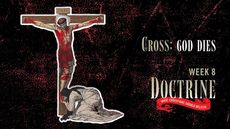My friends at Crossway have been great to work with on Vintage Jesus and other forthcoming books I am publishing both with my co-author Dr. Gerry Breshears and by myself this year. They sent me some prerelease, hush-hush confidential proofs of their forthcoming English Standard Version (ESV) Study Bible to look over and consider endorsing. To be honest, I actually got choked up when I looked through it for the first time because I know what a gift it is to an emerging generation of Bible preachers and teachers who are committed to timeless truth and timely methods.
To test my hypothesis, I showed the confidential proofs to some of our newly converted, well-tattooed indie rockers and they reported that it looked "filthy" and "sick"—for those of you who wear khaki pleated pants and tuck in your shirt, this is a really good endorsement. So, thank you Crossway for the "filthy sick" ESV Study Bible.
Without blowing all of their marketing strategies in preparation for its October 15, 2008 debut, I decided to leak a few details that are particularly exciting.
The ESV Study Bible is the result of extensive work from 93 evangelical Bible scholars from 9 countries representing nearly 20 denominations and over 50 seminaries and Bible colleges. To the best of my knowledge, none of the theological contributors owns a prayer labyrinth or has ever finger painted their doctrinal statement, which is very comforting. Heading up the team are Lane Dennis (Executive Editor), Wayne Grudem (General Editor), J. I. Packer (Theological Editor), C. John Collins (Old Testament Editor), Thomas R. Schreiner (New Testament Editor), and my buddy Justin Taylor (Managing Editor).
The ESV Study Bible includes the 757,000 words of the Bible along with an additional 1.1 million words of theological resources, which is the equivalent of a 20-volume resource library. Those resources include 25,000 notes, over 50 articles, 200 full-color maps, 200 charts, 80,000 cross-references, and some 40 color illustrations that are far cooler than the typical Bible pictures that look like a kindergartner tried to draw the Temple with their left hand. As a geek who always reads the footnotes, I am particularly excited about Clinton Arnold’s work in Colossians and Philemon, Andreas J. Kostenberger’s work in John, Raymond Ortlund’s work in Isaiah, Grant Osborne’s work in James, Simon Gathercole’s work in Galatians, Thomas Schreiner’s work in Romans, 1 and 2 Peter, and Jude, and Frank Thielman’s work in 1 Corinthians.
The theological article lineup is nastier than the heart of the Red Sox order. Here are just some of the titles:
- "The Authority and Truthfulness of the Bible" by Wayne Grudem
- "How to Interpret the Bible" by Daniel Doriani
- "Overview of the Bible" by Vern Poythress
- "Reading the Bible Theologically" by J. I. Packer
- "Reading the Bible as Literature" by Leland Ryken
- "Reading the Bible for Application" by David Powlison
- "Reading the Bible, Prayer, and Communion with God" by John Piper
- "Reading the Bible with the Church" by John Hannah
- "The Bible’s Use in Preaching and Public Worship" by Kent Hughes
- "God’s Plan for Salvation" by Mark Dever
- "The Theology of the New Testament" by Thomas Schreiner
- "Reading the Gospels and Acts" by Darrell Bock
- "Reading the Epistles" by Thomas Schreiner
- "The Canon of the Old Testament" by Roger Beckwith
- "The Old Testament and Critical Scholarship" by Walter Kaiser
- "The New Testament and Critical Scholarship" by Darrell Bock









